Newbury, Berkshire
Up to 1834
In December 1624, Newbury received a bequest of £4,800 in the will of wealthy London draper John Kendrick. The money was designated for several causes but the bulk, £4,000, was to establish a workhouse. The mayor and burgesses were to purchase:
The residue of the bequest was to fund a:
A bequest of £7,500 was made on identical terms for the setting up of a workhouse in Reading.
Newbury purchased a property known as the Castle and an adjoining one-acre meadow in Cheap Street, facing the market square and guildhall, and bordering onto the River Kennet. In July, 1626, Richard Emes, carpenter of Speenhamland was formally appointed to build the new workhouse. Payments for materials used in the building included £81.12s. to Mr Smith for timber, £8.10s. to White for 5,000 bricks, 3,000 tiles, and 15 quarters of lime, and £9.6s. to Maye of Hampstead for 6,000 bricks and 6,000 tiles at 13s.4d. per 1,000.
The new building comprised three ranges at the north, east and south of a central courtyard. The west side was formed by the existing old houses on the site. The east side included an entrance archway to the courtyard. The east range contained a dye-house at its northern end, near to the river from which water was piped. The dye-house had two furnaces and two woad vats, the waste from which was taken back to the river.
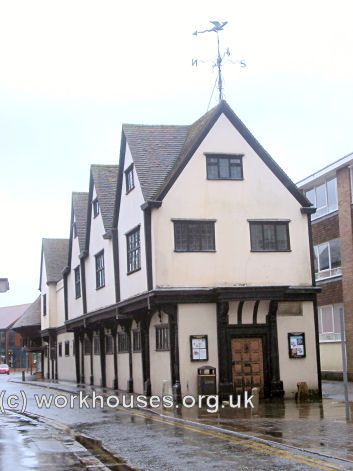
Newbury workhouse south range from the west, 2004. The entrance archway was immediately to the left.
© Peter Higginbotham.
The workhouse operated as an early form of "factory", processing wool through the stages of washing, dying, carding, and spinning although much of the spinning was farmed out to a large number of local spinners. The workhouse had its own weaving shop fitted with four broad looms and one narrow loom.
By 1632, the workhouse was providing employment and training for pauper children. It provided work for up to eighty workers at the workhouse each year, together with spinners and casual workers. The workhouse made a profit in 1629 but then began to lose money and was reorganised in 1636. Three clothiers were given loans of £500 each to provide work for the poor in the workhouse.
The building continued in use as a workhouse and pauper school during the Civil War. By the 1670s, it may have provided accommodation for the poor. By 1689, the east range had been demolished. Income from letting parts of the remainder was used to apprentice poor children. By 1706, part of the building had been converted to a Blue Coat School for boys. In 1730, the second edition of the SPCK's "An Account of Several Work-houses..." mentions a parish workhouse in operation in Newbury accommodating "near 100 persons, young and old".
Following the opening of the Kennet Navigation in 1723, the premises were let for use as a store and then converted to a granary in 1829. The north and west ranges were then demolished. The surviving south range is now used as a museum.
By 1777, Newbury had a workhouse at St Mary Hill, what is now the south end of Cheap Street, where 120 paupers could be accommodated.
Thatcham's workhouse, at the south end of the present-day Broadway, could house forty inmates in 1777. In 1832, they numbered twenty-three, ranging in age from infants to 70 and upwards.
Chieveley's establishment in 1777 could hold twelve inmates, while the fifteen residents of the Speen workhouse in 1832 included four 'idiots'.
After 1834
Newbury Poor Law Union was formed on 17th April, 1835. Its operation was overseen by an elected Board of Guardians, 23 in number, representing its 18 constituent parishes as listed below (figures in brackets indicate numbers of Guardians if more than one):
Berkshire:
Boxford, Brimpton, Chieveley, Enborne, Greenham, Hampstead Marshall, Leckhamstead, Midgham, Newbury (4), Sandleford, Shaw-cum-Donnington, Speen (2), Thatcham (2), Wasing, Welford, Winterbourne, Woolhampton.
Later Additions: Cold Ash (from 1894).
Hampshire:
Newton
The population falling within the Union at the 1831 census had been 19,054 with parishes ranging in size from Sandleford (population 18) to Newbury itself (5,967). The average annual poor-rate expenditure for the period 1832-35 had been £15,756 or 16s.6d per head of the population.
Newbury Union workhouse was built in 1836 to a design by Sampson Kempthorne based on his model cruciform plan for the Poor Law Commissioners. Intended to accommodate 350 inmates, the Commissioners authorized an expenditure of £5,332-19s. on its construction. The building was erected on a site to the south of Newbury, on the eastern side of Newtown Road. Its location and layout can be seen on the 1898 map below:
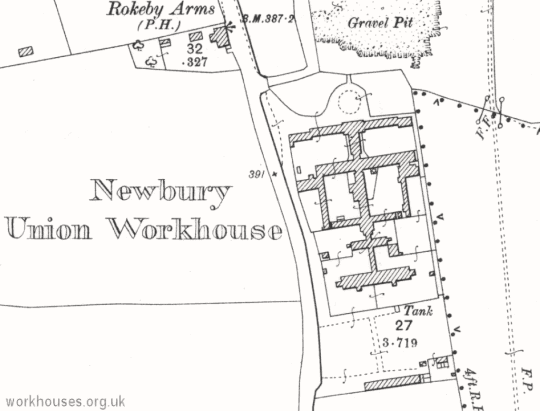
Newbury workhouse site, 1898.
At the north of the site was a two-storey entrance range, now demolished. Running south from the centre rear of the entrance range ran a block connecting to a central hub, from which radiated further ranges to the east, south and west.
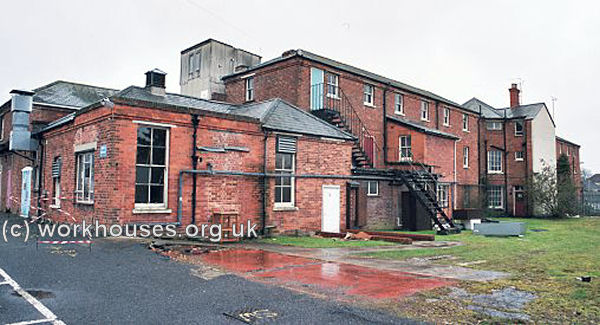
Newbury east range and central hub, 2004.
© Peter Higginbotham.
Further single storey service wings ran from each side of the southern range, that on the west being the original mortuary.

Newbury south-west yard (composite photo) showing west range (left), south range (centre) and mortuary (right), 2004.
© Peter Higginbotham.
The original 1836 infirmary was placed to the south of the south range. It was a T-shaped block with an entrance at the north, later becoming linked to the south range. It had nurses' rooms, shower baths and water closets at the centre, with wards in the wings to the sides each having baths and sicks at their far ends.
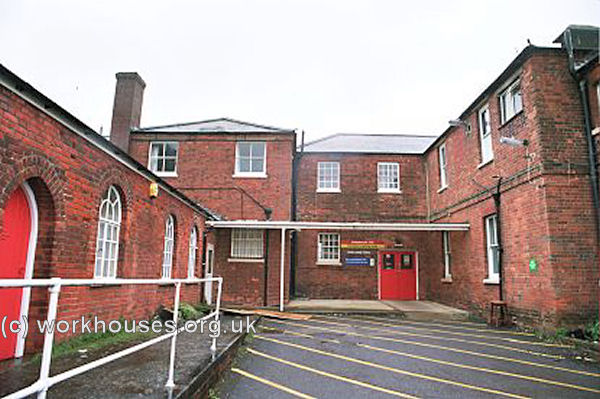
Newbury mortuary (south side) and original infirmary from the west, 2004.
© Peter Higginbotham.
A new and larger infirmary was added further to the south later in the nineteenth century.
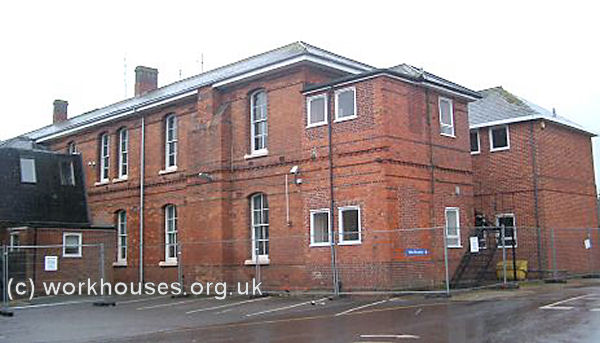
Newbury second infirmary from the north-west, 2004.
© Peter Higginbotham.
From 1904, to help avoid stigma in later life, the birth certificates of those born in the workhouse recorded the location simply as 99 Newtoen Road, Newbury. It was later renumbered as 214 Newtown Road.
In 1930, the site was taken over by Berkshire County Council and redesignated as a Public Assistance Institution.
Under the National Health Service, the workhouse site became Sandleford Hospital, which closed in 2004. The buildings have now been demolished.
Staff
Inmates
Records
Note: many repositories impose a closure period of up to 100 years for records identifying individuals. Before travelling a long distance, always check that the records you want to consult will be available.
- Berkshire Record Office, Berkshire Record Office, 9 Coley Avenue, Reading, Berks RG1 6AF. Holdings include: Guardians' minute books (1835-1930); Admissions and discharges (1866-1947); Births (1836-1947); Deaths (1868-1909, 1914-1943); Punishment register (1915-34); Assessment Committee minutes (1862-1927); etc.
Bibliography
- Higginbotham, Peter Workhouses of London and the South East (2019)
- Jackson, Christine (2004) Functionality, Commemoration and Civic Competition: A Study of Early Seventeenth-Century Workhouse Design and Building in Reading and Newbury in Architectural History, 47, pp77-112.
Links
- None.
Unless otherwise indicated, this page () is copyright Peter Higginbotham. Contents may not be reproduced without permission.


